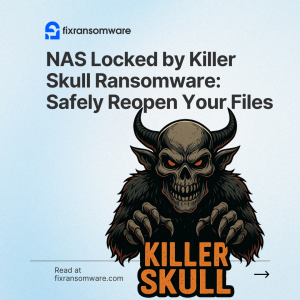When Killer Skull hits a NAS (Synology/QNAP), file access stops, operations stall, and panic spreads. Your goals are clear: limit damage, preserve evidence, and execute a clean restore so data returns safely without corruption or reinfection. If you need hands-on support, start an assessment at FixRansomware.com.
Signs of Killer Skull on NAS
Typical indicators include mass-encrypted or renamed files, ransom notes, sudden storage write spikes, and broken backups. Priorities:
- halt lateral movement,
- preserve artifacts for forensics/insurance,
- prepare a verifiable clean restore plan.
Baseline response principles: CISA Stop Ransomware.
First 30 Minutes: Contain without Destroying Evidence
- Isolate the NAS from the network (LAN/Internet). For dual-NIC models, disable the production-facing port.
- Avoid hard power-offs unless required for safety; preserve state so evidence of Killer Skull remains intact.
- Restrict admin accounts: suspend nonessential access; review recent admin logins and privilege changes.
- Capture evidence: ransom note, timestamps, affected volumes/folders, unusual processes/apps, backup failure logs.
Clean Restore on Synology/QNAP (Safe & Controlled)
Objective: recover files/services cleanly while avoiding data corruption and repeat compromise.
1) Confirm pre-incident backups.
Use immutable/offline repositories the ransomware couldn’t modify. Start with a small test set in an isolated environment—validate integrity (including hashes) and readability before scaling up.
2) Build a clean landing zone.
If needed, provision temporary storage or a file-server VM that’s fully patched and VLAN-isolated. Do not reconnect to production until security checks are complete.
3) Restore by business priority.
Order typically: identity/account data (if applicable), databases, application files, then user documents. Maintain network fencing (no Internet/production reach) during validation.
4) Prevent corruption & reinfection.
Do not overwrite originals before you have a forensic copy. Run filesystem checks. For databases, verify redo/transaction logs and consistency before going “live.”
Vendor references: Synology KB and QNAP How-to for snapshot/restore procedures, volume management, and access controls.
Forensics That Matter in a Killer Skull Case
Common vectors include weak or missing MFA on VPN/admin portals, management interfaces exposed to the Internet, leaked/weak passwords, or a compromised administrator workstation. Collect NAS logs (SMB/NFS access, admin sessions, rsync/FTP), directory/IdP logs, and EDR telemetry from admin hosts. Create read-only images of critical volumes before any invasive action—vital for audits, legal processes, and insurance claims.
Post-Incident Hardening (So It Doesn’t Happen Again)
- Identity & Access
- Enforce MFA for NAS admin consoles; eliminate shared accounts; stop local password reuse.
- Patching & Attack Surface
- Update NAS firmware and packages; disable unused services (FTP/rsync/SSH if not required).
- Separate the management network from user segments; restrict access by IP.
- Ransomware-Resilient Backups
- Apply 3-2-1 (three copies, two media, one immutable/offline). Run restore drills regularly (table-top + live).
- Monitoring & Alerts
- Alert on abnormal write rates/mass rename; forward logs to SIEM; use EDR on admin endpoints.
- Runbook & Exercises
- Document roles, SLAs, and escalation paths; drill quarterly so teams can execute under pressure.
When to Call Specialists
If the blast radius is unclear, backups are broken, or data scale is large, bring in experts. FixRansomware.com provides rapid triage, scoped clean restore, and hardening guidance aligned to best practices—no ransom required.


